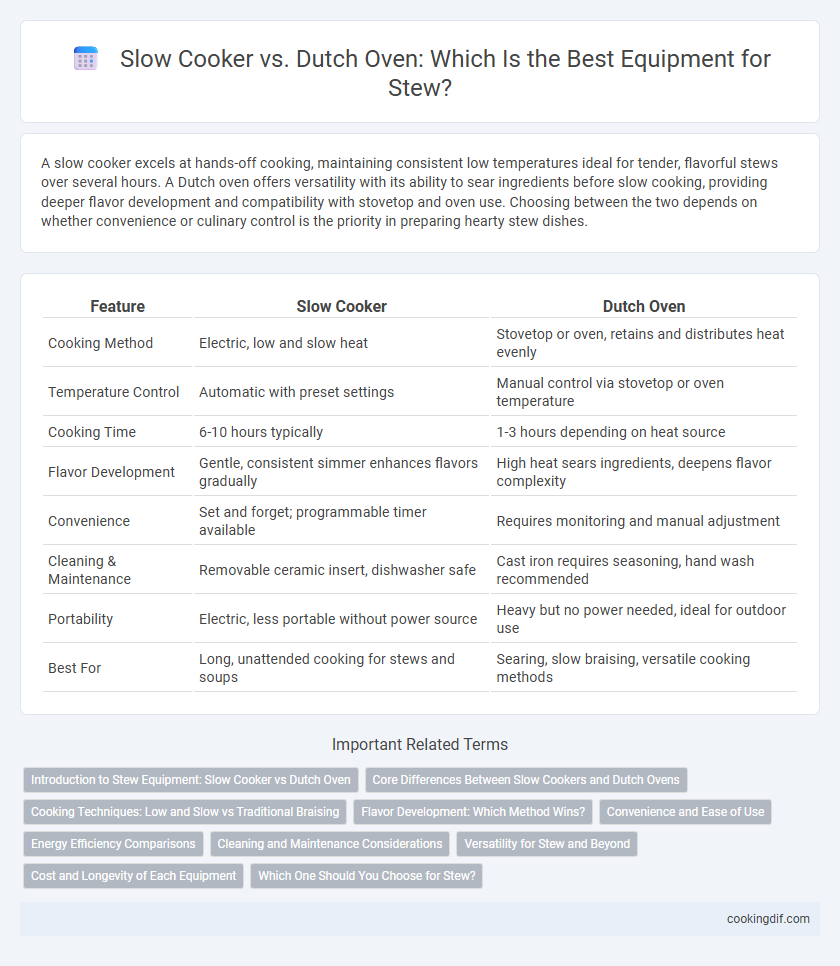A slow cooker excels at hands-off cooking, maintaining consistent low temperatures ideal for tender, flavorful stews over several hours. A Dutch oven offers versatility with its ability to sear ingredients before slow cooking, providing deeper flavor development and compatibility with stovetop and oven use. Choosing between the two depends on whether convenience or culinary control is the priority in preparing hearty stew dishes.
Table of Comparison
| Feature | Slow Cooker | Dutch Oven |
|---|---|---|
| Cooking Method | Electric, low and slow heat | Stovetop or oven, retains and distributes heat evenly |
| Temperature Control | Automatic with preset settings | Manual control via stovetop or oven temperature |
| Cooking Time | 6-10 hours typically | 1-3 hours depending on heat source |
| Flavor Development | Gentle, consistent simmer enhances flavors gradually | High heat sears ingredients, deepens flavor complexity |
| Convenience | Set and forget; programmable timer available | Requires monitoring and manual adjustment |
| Cleaning & Maintenance | Removable ceramic insert, dishwasher safe | Cast iron requires seasoning, hand wash recommended |
| Portability | Electric, less portable without power source | Heavy but no power needed, ideal for outdoor use |
| Best For | Long, unattended cooking for stews and soups | Searing, slow braising, versatile cooking methods |
Introduction to Stew Equipment: Slow Cooker vs Dutch Oven
Slow cookers offer consistent low-temperature cooking ideal for tenderizing tough meat and developing rich flavors over hours without constant supervision. Dutch ovens provide versatile stovetop and oven use with excellent heat retention and even distribution, allowing precise control over browning and simmering. Choosing between these depends on whether convenience or hands-on cooking and heat control are prioritized in stew preparation.
Core Differences Between Slow Cookers and Dutch Ovens
Slow cookers use electric heat and maintain a consistent low temperature for steady, hands-off cooking, ideal for tenderizing tough cuts of meat over several hours. Dutch ovens are heavy, cast-iron pots designed for stovetop or oven use, offering greater control over cooking temperature and the ability to brown ingredients before slow simmering. While slow cookers excel in convenience and energy efficiency, Dutch ovens provide versatility and superior heat retention for complex flavor development in stews.
Cooking Techniques: Low and Slow vs Traditional Braising
Slow cookers maintain a consistent low temperature ideal for breaking down tough meat fibers over extended periods, resulting in tender, flavorful stew. Dutch ovens utilize traditional braising methods with higher initial heat, creating a rich caramelized crust before slow simmering to develop depth of flavor. Both techniques enhance stew complexity, but slow cooking suits hands-off preparation while braising offers more control over texture and browning.
Flavor Development: Which Method Wins?
Slow cookers excel at tenderizing meat through prolonged, low-temperature cooking, allowing flavors to meld gently over time, but they may lack the depth achieved by initial caramelization. Dutch ovens promote superior flavor development by enabling high-heat searing and browning, which creates complex Maillard reactions, enriching the stew's taste profile. For maximum flavor depth and richness, the Dutch oven method typically outperforms slow cookers in stew preparation.
Convenience and Ease of Use
Slow cookers offer unmatched convenience with programmable timers and automatic shut-off features, allowing for hands-off cooking and perfect stew results. Dutch ovens, while requiring stovetop or oven attention, provide versatile cooking options and superior heat retention for rich, deeply flavored stews. Choosing between the two depends on prioritizing ease of use and time management versus cooking control and traditional methods.
Energy Efficiency Comparisons
Slow cookers consume significantly less electricity compared to Dutch ovens used on stovetops, making them more energy-efficient for long cooking processes such as stews. Dutch ovens, typically made of cast iron, retain heat well but require continuous stove use, which can lead to higher energy consumption. Choosing a slow cooker reduces energy usage by maintaining low, consistent temperatures without the need for constant monitoring.
Cleaning and Maintenance Considerations
Slow cookers feature removable, dishwasher-safe ceramic inserts, making cleaning straightforward and convenient for busy households. Dutch ovens, typically made from cast iron with an enamel coating, require hand washing and careful drying to prevent rust and preserve the seasoning. Regular maintenance of Dutch ovens involves seasoning and avoiding abrasive cleaners, whereas slow cookers demand minimal upkeep beyond routine cleaning.
Versatility for Stew and Beyond
A slow cooker offers unmatched convenience with programmable settings ideal for hands-off, long-cooking stews that develop deep flavors and tender meats. A Dutch oven excels in versatility, providing the ability to sear, saute, and simmer both on stovetop and in the oven, making it suitable for a wider range of recipes beyond stew, including bread baking and roasting. Chefs seeking multifunctional cookware often prefer a Dutch oven for its direct heat control and adaptability across various cooking techniques.
Cost and Longevity of Each Equipment
Slow cookers generally cost between $30 and $100, offering affordable options with digital features, while Dutch ovens range from $50 to $300, reflecting their cast iron build and brand prestige. Slow cookers have electronic components prone to wear over 5-10 years, whereas Dutch ovens boast exceptional longevity, often lasting decades with proper care due to their durable cast iron construction. Investing in a Dutch oven provides a long-term cooking tool that can withstand high heat and frequent use, while slow cookers offer cost-effective convenience but may require replacement sooner.
Which One Should You Choose for Stew?
A slow cooker offers convenience with consistent low heat and hands-off cooking, perfect for tenderizing tougher cuts of meat in stew. A Dutch oven provides superior heat retention and the ability to sear ingredients before slow simmering, enhancing flavor complexity for richer stews. Choose a slow cooker for ease and set-it-and-forget-it meals, while a Dutch oven suits those seeking more control and traditional stovetop-to-oven versatility.
Slow Cooker vs Dutch Oven for equipment Infographic

 cookingdif.com
cookingdif.com